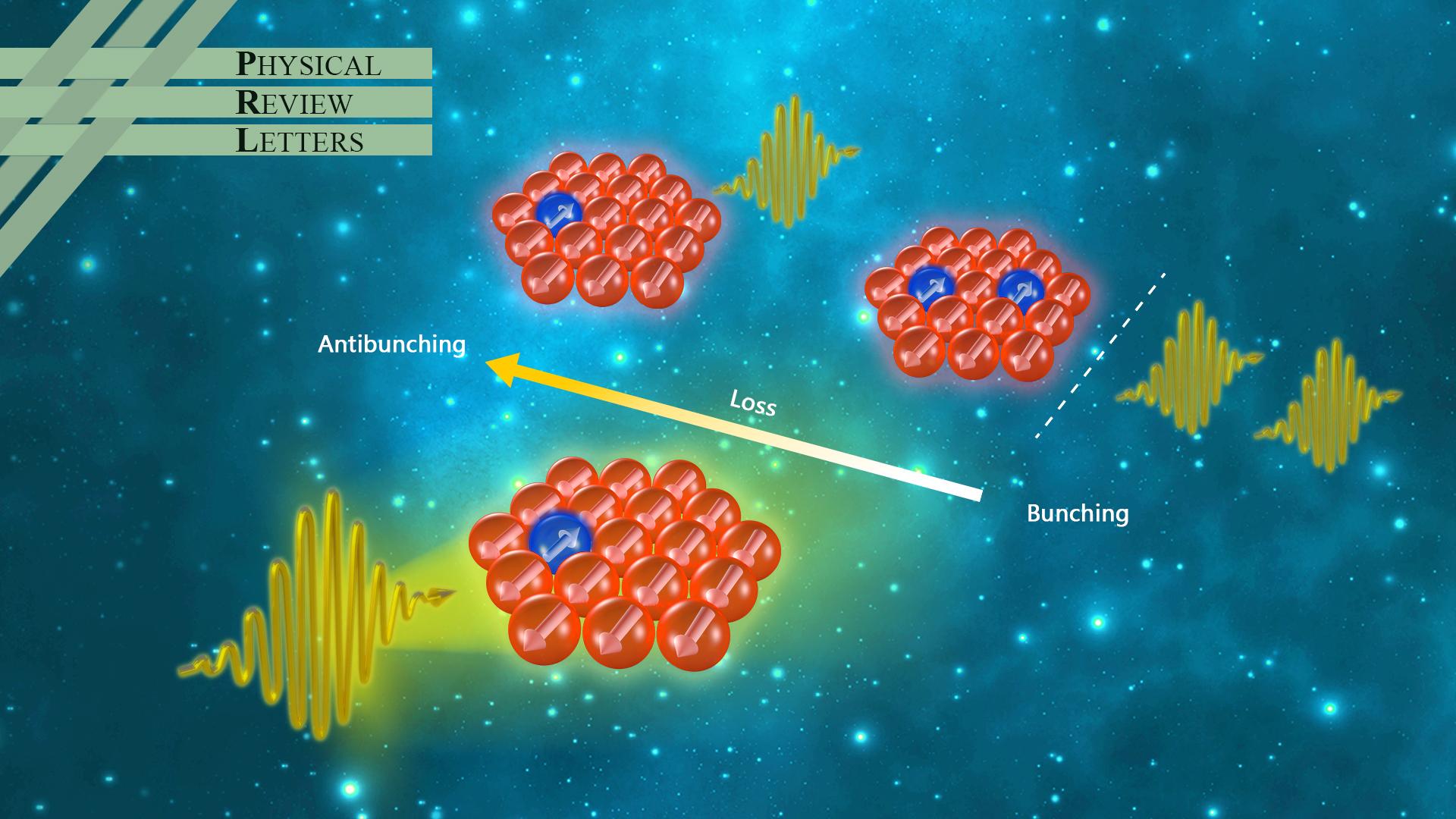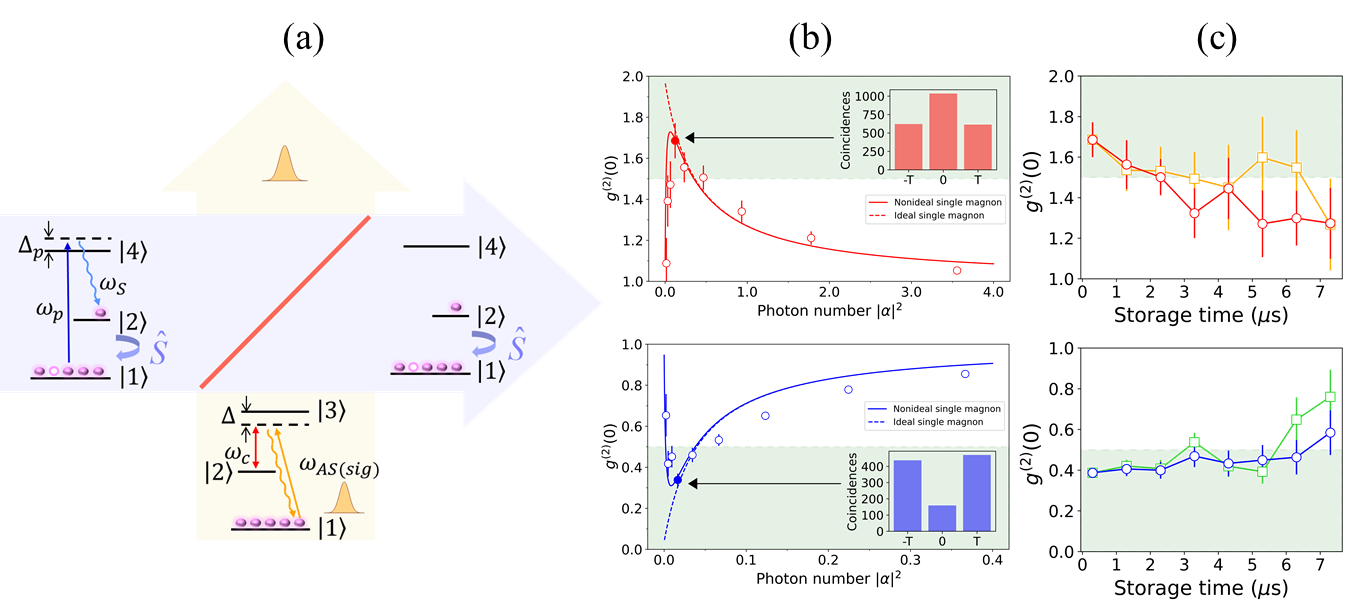近日,南方科技大学量子科学与工程研究院副教授陈洁菲课题组在探索新型原子-光非厄米界面研究中取得突破性进展,相关研究成果以“Quantum Interference between Photons and Single Quanta of Stored Atomic Coherence”为题发表在国际物理顶级学术期刊《物理评论快报》。

物理系统的厄米性可以通过增益或者耗散的引入而改变,开放系统与环境热库之间的能量交换可让这类光学介质系统展示出奇特的光学特性。然而,由于增益或耗散被认为对量子态有害,一般认为非厄米物理只局限在经典光学范畴。最近,超材料等人工光学系统中形成的非厄米分束元件,通过量子干涉展现人工元件对光子这类玻色子聚束行为的操控。当两个玻色子分别同时经过一个半透半反的分束器两端并发生双粒子量子干涉后,玻色子倾向于选择同一个输出端口而表现出聚束效应;而费米子则表现出反聚束效应,倾向于各自选择一个输出端口。在这些量子干涉实验演示中,研究人员利用的都是相同类型的玻色子。
另一方面,原子-光量子态的高效转换是光学量子存储的核心,因此原子-光界面的探索在光学量子存储、量子网络等方面具有重要的应用前景。存储在原子系综中的“光子”以原子相干集体激发的形式存在,且能等效为一种准粒子激发——“磁子”(magnon)。自由飞行的光子与存储起来的“光子”都是玻色子,飞行的光子以光速在自由空间飞行,而“磁子”则局限在原子系综中且能相干地被读出为飞行的光子。气态原子系综的外层电子能级丰富,其与光场之间的相互耦合形成的光-原子界面能够用于探索非厄米界面。在此研究中,研究人员首次演示了光子和磁子这两种不同类玻色子的量子干涉,其聚束行为受非厄米界面的调控。

原子-光界面的线性分束模型及主要实验结果:(a) 飞行光子与存储光子的分束元件模型;(b) Hong-Ou-Mandel干涉对比度与单光子脉冲光子数关系;(c) 干涉对比度与磁子的存储时间关系。
实验中,研究人员首先利用一束远失谐的泵浦激光场将基态原子激发到虚能级并进而发生拉曼激发过程,结果其中一个原子被泵浦到另外一个亚稳态能级而形成一个单磁子,与此同时释放出一个光子,通过探测这个光子便能知道是否产生了单个磁子。在光量子存储中,飞行的光子可以相干地转换为相干集体激发形式。若一个单光子可以被转换为一个磁子并存储下来,且可以按需读出与原来相同模式的飞行光子,原子-光界面就构成了光子-磁子之间的一个分束器,如图(a)所示。研究人员利用的正是该机制在激光冷却和囚禁的冷原子团上实现了不同玻色子间的量子干涉实验。如图(b)所示,研究人员利用Fock态的单磁子与平均光子数小于1的单光子脉冲进行著名的Hong-Ou-Mandel干涉,并在实验中平衡两种玻色子输入的比例以得到最好的干涉对比度,超越了经典干涉的极限进入量子干涉区域(绿色区域代表)。此系统的厄米性可由增加原子和光相互作用通道的损耗而进行调控,在厄米系统中的玻色子聚束行为(下图)能够调控为非厄米系统中的反聚束行为(上图)。在图(c)中,研究人员让原子-光界面中存储的磁子与自由空间飞行的光子进行干涉。结果表明在一定的存储时间内,存储的磁子仍然能与飞行光子干涉并进入量子区域,显示它们具有不可分辨性。
该研究成功演示了非厄米物理能够有效控制单量子激发的统计行为。其演示的物理模型同时适用于所有类似结构的物质-光界面,且因热噪声得以有效控制此系统工作在单量子水平。由此,厄米性这个自由度可有效成为操控光-物质界面的新手段。
南科大为论文第一单位,南科大量子科学与工程研究院副教授陈洁菲及副研究员Georgios A. Siviloglou为论文通讯作者,量子科学与工程研究院博士研究生王兴昌、王建民分别为第一、第二作者。中国科学技术大学教授邹长铃为该工作做出了重要贡献。该研究得到了国家自然科学基金、广东省重点实验室、深圳市重点实验室和南方科技大学的大力支持。
论文链接:https://link.aps.org/doi/10.1103/PhysRevLett.128.083605